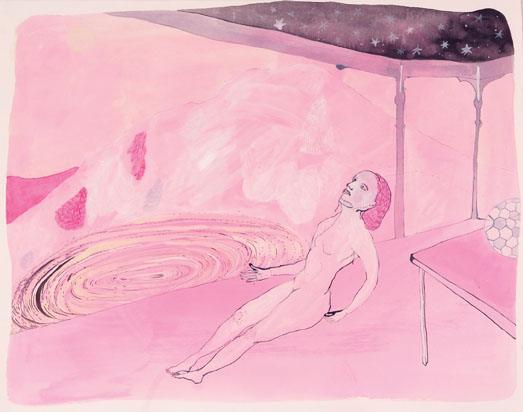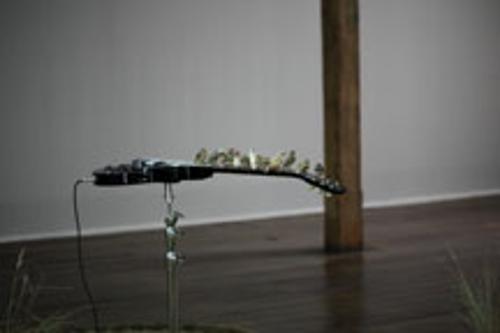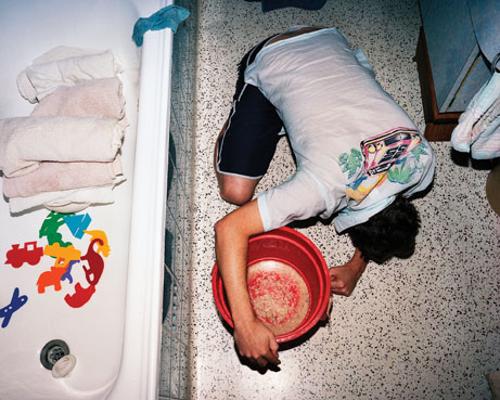
There is an image in 'Better Places', by Benjamin Armstrong from his 'Sorcery' series, of what looks like a very fleshy 'body' being prised open by surgical retractors to reveal a black space within. In the centre of this space is a small white dot. This small white dot represents very much what this show is about. Some of the artists suggest a better place may exist externally and are happy to go looking for it, whereas others stay put and look within. Artists have done this forever. Sometimes they oscillate between the two – when things get a bit 'hot' out there, they retreat and work on ideas and visions in the privacy and intimacy of the studio.
We now may be entering a time when there is a lot of retreating going on. The art market seems to be hanging on as I write, but it is fair to say that the talk around town is to forget the commercial arm of your practice for a while and knuckle down on your ideas. Who knows? You may even be able to suggest a way out of this mess. Or, as in the history of film, give us space to dream of better worlds and at the very least, distract us from the misery.
Back to Armstrong's work: this series of seven works fits very much into the 'internal' camp. Like so many artists, from Louise Bourgeois to Jonathon Borofsky or Raymond Pettibon, there is such a pure and unadulterated joy at making images from deep within the unconscious here. Psychologically suggestive of body parts and furtive, unformed sexual experience, the better world here is possibly the world of perfect union, where one is no longer alone and the single dot becomes two.
Interestingly, another work which probes deep within a 'body' is Raquel Ormella's '130 Davey Street'. Presented very much like an archaeological dig in progress, this important and much lauded work presents a series of extremely detailed drawings on whiteboards based on photographs taken of the Wilderness Society's Hobart campaign centre.
Artists continue to be employed on archaeological digs, despite the advances in photography and other image capture technology because they can differentiate and emphasise layers in their work. Utilising ongoing dialogue with archaeologists, they are able to read complex and subtle differences in unearthed material that has been entombed in time in a manner beyond the capability of new media.
Similarly Ormella has captured time and the subtle layers of a particular site and in the process revealed a rhapsodic aesthetics from office miscellanea – files, crowded desks, computers, whiteboards and walls plastered with layers of notices and images. Of course, the focus of much of this 'unaesthetic' material is the preservation of unique and 'aesthetic' natural wilderness. The critical tension that the work achieves comes from such an unexpected delivery of image, and is equally reinforced by the fact that the image remains slippery – how easy and satisfying it would be to rub it all off and say 'this world does not exist'! I am sure there are many who would concur.
Clare Davies' works reminded me of the early work of Melbourne artist Peter Graham, who also spent time in the Tasmanian wilderness, making work about the search for the Tasmanian tiger. Davies work is not so much a search, as an immersion. We have definitely arrived and been absorbed into this world. When the drawings spilled over onto the walls of the space, I felt as if some of the magic was lost. As the drawings joined the world of the Perth Institute of Contemporary Arts I was less inclined to believe in this other world. The power of William Blake's vision and words was reliant on its concentration within books and on the page.
To make work about better places is to convince us to linger and believe, even to subscribe or reject what this world offers. The best work in this exhibition does exactly that. But as we enter uncertain times, artists will continue to tread the well-trodden path between internal and external worlds. I had the feeling Paul Cézanne worked this out efficiently by focusing on three 'worlds': after going out in the open to paint Mont Saint-Victoire, he would grumble and head back into the forest to paint the interstices of the branches sous-bois. When this wasn't working at all or the weather became inclement, he would reluctantly head back into his studio, set up some plaster fruit and toil away, waiting for the sun to come out.












